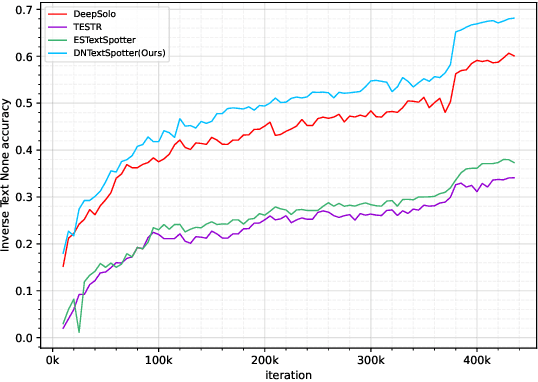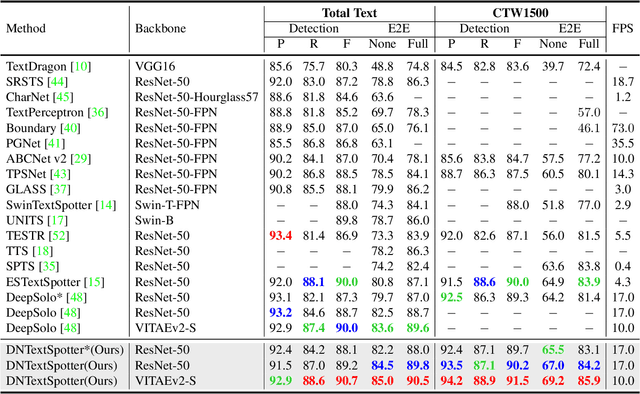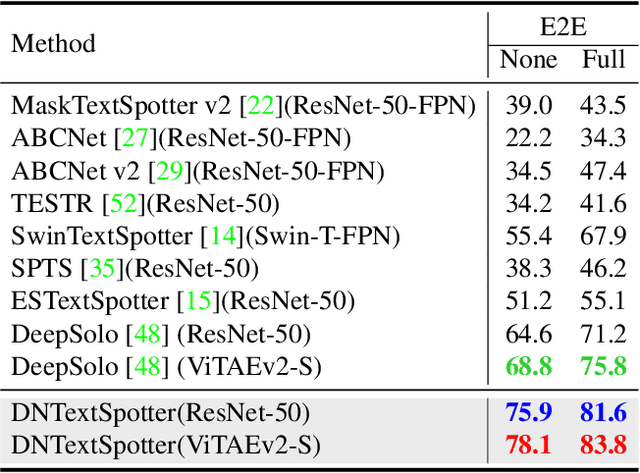Curved Text Detection
Curved text detection is the process of identifying and localizing text that is curved or non-linear in images.
Papers and Code
Generalized Visual Relation Detection with Diffusion Models
Apr 16, 2025Visual relation detection (VRD) aims to identify relationships (or interactions) between object pairs in an image. Although recent VRD models have achieved impressive performance, they are all restricted to pre-defined relation categories, while failing to consider the semantic ambiguity characteristic of visual relations. Unlike objects, the appearance of visual relations is always subtle and can be described by multiple predicate words from different perspectives, e.g., ``ride'' can be depicted as ``race'' and ``sit on'', from the sports and spatial position views, respectively. To this end, we propose to model visual relations as continuous embeddings, and design diffusion models to achieve generalized VRD in a conditional generative manner, termed Diff-VRD. We model the diffusion process in a latent space and generate all possible relations in the image as an embedding sequence. During the generation, the visual and text embeddings of subject-object pairs serve as conditional signals and are injected via cross-attention. After the generation, we design a subsequent matching stage to assign the relation words to subject-object pairs by considering their semantic similarities. Benefiting from the diffusion-based generative process, our Diff-VRD is able to generate visual relations beyond the pre-defined category labels of datasets. To properly evaluate this generalized VRD task, we introduce two evaluation metrics, i.e., text-to-image retrieval and SPICE PR Curve inspired by image captioning. Extensive experiments in both human-object interaction (HOI) detection and scene graph generation (SGG) benchmarks attest to the superiority and effectiveness of Diff-VRD.
Edge Approximation Text Detector
Apr 05, 2025Pursuing efficient text shape representations helps scene text detection models focus on compact foreground regions and optimize the contour reconstruction steps to simplify the whole detection pipeline. Current approaches either represent irregular shapes via box-to-polygon strategy or decomposing a contour into pieces for fitting gradually, the deficiency of coarse contours or complex pipelines always exists in these models. Considering the above issues, we introduce EdgeText to fit text contours compactly while alleviating excessive contour rebuilding processes. Concretely, it is observed that the two long edges of texts can be regarded as smooth curves. It allows us to build contours via continuous and smooth edges that cover text regions tightly instead of fitting piecewise, which helps avoid the two limitations in current models. Inspired by this observation, EdgeText formulates the text representation as the edge approximation problem via parameterized curve fitting functions. In the inference stage, our model starts with locating text centers, and then creating curve functions for approximating text edges relying on the points. Meanwhile, truncation points are determined based on the location features. In the end, extracting curve segments from curve functions by using the pixel coordinate information brought by truncation points to reconstruct text contours. Furthermore, considering the deep dependency of EdgeText on text edges, a bilateral enhanced perception (BEP) module is designed. It encourages our model to pay attention to the recognition of edge features. Additionally, to accelerate the learning of the curve function parameters, we introduce a proportional integral loss (PI-loss) to force the proposed model to focus on the curve distribution and avoid being disturbed by text scales.
Advancing Chronic Tuberculosis Diagnostics Using Vision-Language Models: A Multi modal Framework for Precision Analysis
Mar 17, 2025Background This study proposes a Vision-Language Model (VLM) leveraging the SIGLIP encoder and Gemma-3b transformer decoder to enhance automated chronic tuberculosis (TB) screening. By integrating chest X-ray images with clinical data, the model addresses the challenges of manual interpretation, improving diagnostic consistency and accessibility, particularly in resource-constrained settings. Methods The VLM architecture combines a Vision Transformer (ViT) for visual encoding and a transformer-based text encoder to process clinical context, such as patient histories and treatment records. Cross-modal attention mechanisms align radiographic features with textual information, while the Gemma-3b decoder generates comprehensive diagnostic reports. The model was pre-trained on 5 million paired medical images and texts and fine-tuned using 100,000 chronic TB-specific chest X-rays. Results The model demonstrated high precision (94 percent) and recall (94 percent) for detecting key chronic TB pathologies, including fibrosis, calcified granulomas, and bronchiectasis. Area Under the Curve (AUC) scores exceeded 0.93, and Intersection over Union (IoU) values were above 0.91, validating its effectiveness in detecting and localizing TB-related abnormalities. Conclusion The VLM offers a robust and scalable solution for automated chronic TB diagnosis, integrating radiographic and clinical data to deliver actionable and context-aware insights. Future work will address subtle pathologies and dataset biases to enhance the model's generalizability, ensuring equitable performance across diverse populations and healthcare settings.
Context-Aware Vision Language Foundation Models for Ocular Disease Screening in Retinal Images
Mar 19, 2025Foundation models are large-scale versatile systems trained on vast quantities of diverse data to learn generalizable representations. Their adaptability with minimal fine-tuning makes them particularly promising for medical imaging, where data variability and domain shifts are major challenges. Currently, two types of foundation models dominate the literature: self-supervised models and more recent vision-language models. In this study, we advance the application of vision-language foundation (VLF) models for ocular disease screening using the OPHDIAT dataset, which includes nearly 700,000 fundus photographs from a French diabetic retinopathy (DR) screening network. This dataset provides extensive clinical data (patient-specific information such as diabetic health conditions, and treatments), labeled diagnostics, ophthalmologists text-based findings, and multiple retinal images for each examination. Building on the FLAIR model $\unicode{x2013}$ a VLF model for retinal pathology classification $\unicode{x2013}$ we propose novel context-aware VLF models (e.g jointly analyzing multiple images from the same visit or taking advantage of past diagnoses and contextual data) to fully leverage the richness of the OPHDIAT dataset and enhance robustness to domain shifts. Our approaches were evaluated on both in-domain (a testing subset of OPHDIAT) and out-of-domain data (public datasets) to assess their generalization performance. Our model demonstrated improved in-domain performance for DR grading, achieving an area under the curve (AUC) ranging from 0.851 to 0.9999, and generalized well to ocular disease detection on out-of-domain data (AUC: 0.631-0.913).
OFF-CLIP: Improving Normal Detection Confidence in Radiology CLIP with Simple Off-Diagonal Term Auto-Adjustment
Mar 03, 2025



Contrastive Language-Image Pre-Training (CLIP) has enabled zero-shot classification in radiology, reducing reliance on manual annotations. However, conventional contrastive learning struggles with normal case detection due to its strict intra-sample alignment, which disrupts normal sample clustering and leads to high false positives (FPs) and false negatives (FNs). To address these issues, we propose OFF-CLIP, a contrastive learning refinement that improves normal detection by introducing an off-diagonal term loss to enhance normal sample clustering and applying sentence-level text filtering to mitigate FNs by removing misaligned normal statements from abnormal reports. OFF-CLIP can be applied to radiology CLIP models without requiring any architectural modifications. Experimental results show that OFF-CLIP significantly improves normal classification, achieving a 0.61 Area under the curve (AUC) increase on VinDr-CXR over CARZero, the state-of-the-art zero-shot classification baseline, while maintaining or improving abnormal classification performance. Additionally, OFF-CLIP enhances zero-shot grounding by improving pointing game accuracy, confirming better anomaly localization. These results demonstrate OFF-CLIP's effectiveness as a robust and efficient enhancement for medical vision-language models.
Detecting Dark Patterns in User Interfaces Using Logistic Regression and Bag-of-Words Representation
Dec 09, 2024Dark patterns in user interfaces represent deceptive design practices intended to manipulate users' behavior, often leading to unintended consequences such as coerced purchases, involuntary data disclosures, or user frustration. Detecting and mitigating these dark patterns is crucial for promoting transparency, trust, and ethical design practices in digital environments. This paper proposes a novel approach for detecting dark patterns in user interfaces using logistic regression and bag-of-words representation. Our methodology involves collecting a diverse dataset of user interface text samples, preprocessing the data, extracting text features using the bag-of-words representation, training a logistic regression model, and evaluating its performance using various metrics such as accuracy, precision, recall, F1-score, and the area under the ROC curve (AUC). Experimental results demonstrate the effectiveness of the proposed approach in accurately identifying instances of dark patterns, with high predictive performance and robustness to variations in dataset composition and model parameters. The insights gained from this study contribute to the growing body of knowledge on dark patterns detection and classification, offering practical implications for designers, developers, and policymakers in promoting ethical design practices and protecting user rights in digital environments.
Detecting Redundant Health Survey Questions Using Language-agnostic BERT Sentence Embedding (LaBSE)
Dec 05, 2024



The goal of this work was to compute the semantic similarity among publicly available health survey questions in order to facilitate the standardization of survey-based Person-Generated Health Data (PGHD). We compiled various health survey questions authored in both English and Korean from the NIH CDE Repository, PROMIS, Korean public health agencies, and academic publications. Questions were drawn from various health lifelog domains. A randomized question pairing scheme was used to generate a Semantic Text Similarity (STS) dataset consisting of 1758 question pairs. Similarity scores between each question pair were assigned by two human experts. The tagged dataset was then used to build three classifiers featuring: Bag-of-Words, SBERT with BERT-based embeddings, and SBRET with LaBSE embeddings. The algorithms were evaluated using traditional contingency statistics. Among the three algorithms, SBERT-LaBSE demonstrated the highest performance in assessing question similarity across both languages, achieving an Area Under the Receiver Operating Characteristic (ROC) and Precision-Recall Curves of over 0.99. Additionally, it proved effective in identifying cross-lingual semantic similarities.The SBERT-LaBSE algorithm excelled at aligning semantically equivalent sentences across both languages but encountered challenges in capturing subtle nuances and maintaining computational efficiency. Future research should focus on testing with larger multilingual datasets and on calibrating and normalizing scores across the health lifelog domains to improve consistency. This study introduces the SBERT-LaBSE algorithm for calculating semantic similarity across two languages, showing it outperforms BERT-based models and the Bag of Words approach, highlighting its potential to improve semantic interoperability of survey-based PGHD across language barriers.
A Multi-Agent Framework for Extensible Structured Text Generation in PLCs
Dec 03, 2024Programmable Logic Controllers (PLCs) are microcomputers essential for automating factory operations. Structured Text (ST), a high-level language adhering to the IEC 61131-3 standard, is pivotal for PLCs due to its ability to express logic succinctly and to seamlessly integrate with other languages within the same standard. However, vendors develop their own customized versions of ST, and the lack of comprehensive and standardized documentation for the full semantics of ST has contributed to inconsistencies in how the language is implemented. Consequently, the steep learning curve associated with ST, combined with ever-evolving industrial requirements, presents significant challenges for developers. In response to these issues, we present AutoPLC, an LLM-based approach designed to automate the generation of vendor-specific ST code. To facilitate effective code generation, we first built a comprehensive knowledge base, including Rq2ST Case Library (requirements and corresponding implementations) and Instruction libraries. Then we developed a retrieval module to incorporate the domain-specific knowledge by identifying pertinent cases and instructions, guiding the LLM to generate code that meets the requirements. In order to verify and improve the quality of the generated code, we designed an adaptable code checker. If errors are detected, we initiate an iterative self-improvement process to instruct the LLM to revise the generated code. We evaluate AutoPLC's performance against seven state-of-the-art baselines using three benchmarks, one for open-source basic ST and two for commercial Structured Control Language (SCL) from Siemens. The results show that our approach consistently achieves superior performance across all benchmarks. Ablation study emphasizes the significance of our modules. Further manual analysis confirm the practical utility of the ST code generated by AutoPLC.
DNTextSpotter: Arbitrary-Shaped Scene Text Spotting via Improved Denoising Training
Aug 01, 2024



More and more end-to-end text spotting methods based on Transformer architecture have demonstrated superior performance. These methods utilize a bipartite graph matching algorithm to perform one-to-one optimal matching between predicted objects and actual objects. However, the instability of bipartite graph matching can lead to inconsistent optimization targets, thereby affecting the training performance of the model. Existing literature applies denoising training to solve the problem of bipartite graph matching instability in object detection tasks. Unfortunately, this denoising training method cannot be directly applied to text spotting tasks, as these tasks need to perform irregular shape detection tasks and more complex text recognition tasks than classification. To address this issue, we propose a novel denoising training method (DNTextSpotter) for arbitrary-shaped text spotting. Specifically, we decompose the queries of the denoising part into noised positional queries and noised content queries. We use the four Bezier control points of the Bezier center curve to generate the noised positional queries. For the noised content queries, considering that the output of the text in a fixed positional order is not conducive to aligning position with content, we employ a masked character sliding method to initialize noised content queries, thereby assisting in the alignment of text content and position. To improve the model's perception of the background, we further utilize an additional loss function for background characters classification in the denoising training part.Although DNTextSpotter is conceptually simple, it outperforms the state-of-the-art methods on four benchmarks (Total-Text, SCUT-CTW1500, ICDAR15, and Inverse-Text), especially yielding an improvement of 11.3% against the best approach in Inverse-Text dataset.
Text in the Dark: Extremely Low-Light Text Image Enhancement
Apr 22, 2024



Extremely low-light text images are common in natural scenes, making scene text detection and recognition challenging. One solution is to enhance these images using low-light image enhancement methods before text extraction. However, previous methods often do not try to particularly address the significance of low-level features, which are crucial for optimal performance on downstream scene text tasks. Further research is also hindered by the lack of extremely low-light text datasets. To address these limitations, we propose a novel encoder-decoder framework with an edge-aware attention module to focus on scene text regions during enhancement. Our proposed method uses novel text detection and edge reconstruction losses to emphasize low-level scene text features, leading to successful text extraction. Additionally, we present a Supervised Deep Curve Estimation (Supervised-DCE) model to synthesize extremely low-light images based on publicly available scene text datasets such as ICDAR15 (IC15). We also labeled texts in the extremely low-light See In the Dark (SID) and ordinary LOw-Light (LOL) datasets to allow for objective assessment of extremely low-light image enhancement through scene text tasks. Extensive experiments show that our model outperforms state-of-the-art methods in terms of both image quality and scene text metrics on the widely-used LOL, SID, and synthetic IC15 datasets. Code and dataset will be released publicly at https://github.com/chunchet-ng/Text-in-the-Dark.
 Add to Chrome
Add to Chrome Add to Firefox
Add to Firefox Add to Edge
Add to Edge